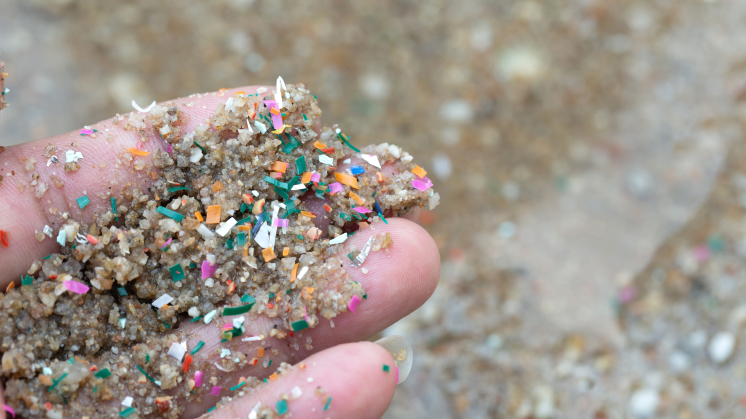What are microplastics?
The source of microplastics, where they are found, and the dangers they pose
Since plastic was first introduced in the 1950s, some 10 billion metric tons of plastic waste has been generated. Less than 10% of that total has been recycled, according to the United Nations Environment Programme (UNEP). Tragically, the planet has become a dumping ground for this debris, which includes everything from bottles and bags, to microplastics. These tiny particles of plastics have been found in the most unexpected places, from the peak of Mount Everest to the deepest trenches of the sea, and even in the breath of dolphins.


Microplastics make their way into farmland due to sewage sludge used as a fertilizer, and then end up in waterways thanks to runoff from the top level of soil
What are microplastics and where do they come from?
Microplastics are defined as particles of plastics that range from just one micrometer across, which is around 1/100th the width of a human hair, to as big as five millimetres. They are either manufactured for a specific use, such as microbeads used as exfoliants in beauty products or toothpastes, or they come from large pieces of plastic that have broken down from items such as bottles or tires.
Where do microplastics come from?
- Personal care products 57Kt
- Plastic pellets 254Kt
- Tyres 973Kt
- Synthetic textiles 211Kt
- Paint 1,301Kt
- Macro plastic (to become microplastic) 7,568Kt
- Leakage by source in Kt
- 0
- 2,000
- 8,000
Source: The Conversation
Where microplastics are found
How humans and animals ingest microplastics
Scientists and researchers have found widespread evidence that microplastics are ending up in human bodies, as well those of animals. A university investigation carried out in 2017 analysed 12 brands of beer that used water drawn from the Great Lakes in North America. All of the samples they examined contained small particles of plastic – particles that will be ingested by anyone who drinks that beer. Researchers at Penn State determined that the typical American ingests more than 5,800 plastic particles every year from their intake of water, beer and sea salt alone. What’s more, humans are also inhaling plastic when they breathe.
Microplastics have already been discovered inside more than 1,300 animal species, according to The Conversation, including fish, mammals, birds and insects. Many animals think that the particles are food and ingest them, which can cause them damage such as blocked intestinal tracts. Animals are also harmed when the plastics inside them release the chemicals that they contain, or other compounds that they are carrying.
How microplastics enter the body
Inhalation
Microplastics can become airborne from the wear and tear of plastic items and synthetic textiles, leading to inhalation.
Dietary intake
Microplastics are found in seafood, salt, beer, honey, and both tap and bottled water, among other food and beverage products.
Dermal absorption
Microplastics are present in various consumer products, including cosmetics and personal care items, leading to potential ingestion or skin contact.
Source: The Conversation
The health risks of microplastics
While there is no doubt among scientists that microplastics are ending up in our bodies, what is yet to be fully understood is the effect that they are having. Over recent years researchers in Austria have found polymer particles smaller than five millimetres in the stool samples of people from eight different countries, while research in California and the Netherlands also located them in lungs, blood, hair and fingernails.
Microplastic fibres – i.e. those associated with the polymers used in clothing, such as fleeces – are more likely to attach to the body or to get entangled inside it, according to Penn State research, given their elongated shape. The World Economic Forum reports that microplastics have not only been found in human blood, but also in our brains. The international organisation points to the possibility that microplastics can increase the likelihood of a heart attack, stroke and even death.
Is the presence of microplastics rising?
The researchers from Penn State who investigated microplastics found that their presence in the environment rose each decade until 2010, but then actually fell between 2010 and 2020. The team said that this warranted further study, but researchers have suggested that the fall could be down to an increase in plastic recycling. Figures from the US Environmental Protection Agency (EPA) appear to back this up, with the amount of recycled plastic just 0.3% of the total in 1980, but rising to nearly 8% in 2010.
The United Nations Environment Programme (UNEP) has a stark warning though: as well as the 19 to 23 million tonnes of plastic waste that it estimates currently leak into aquatic ecosystems every year, it forecasts that these emissions into lakes, rivers and seas will nearly triple by 2040 if no meaningful action is taken.
What can be done to combat microplastics?
For consumers, there are a number of steps to be taken to reduce the amounts of microplastics that they are either ingesting or releasing into the environment. These include:
- Ditching bottled water for a refillable water bottle, preferably made of stainless steel.
- Buying clothes made with natural fibres rather than synthetics, and using a microfibre filter when doing laundry.
- Reusing shopping bags and avoiding buying plastic ones every time you shop.
- Keeping your snacks and other foods in reusable containers instead of disposable plastic ones.
Meanwhile, scientists and researchers are investigating methods to collect microplastics, including a tiny robot fish that has been developed at Sichuan University that can collect the particles. Another technique being developed uses vegetable oil, iron oxide and magnets, and has been found to be 87% effective at extracting microplastics from water.
Scientists in China have resorted to a biodegradable sponge made up of squid bones and cotton to remove microplastics, according to a study published in Science Advances. They used the special sponge in four different samples – pond water, irrigation water, lake water and sea water – and found that it removed up to 99.9% of microplastics.
Governments are also taking action. A number of countries have already banned microplastics in cosmetics, while France has mandated the installation of filters in washing machines to intercept microfibers, according to a study published in Science magazine. There are also multinational policies, such as the European Union’s Marine Strategy Framework Directive, which was put in place to protect the marine ecosystem and biodiversity, and its REACH (Registration, Evaluation, Authorisation and Restriction of Chemicals) legislation, which addresses the production and use of chemical substances and their potential impacts on the environment.
The same study, however, warns that there is a potential for future wide-scale environmental harm from microplastics if no decisive action is taken.

World Water Day 2024
Importance, history and Interesting facts about water

Food sustainability
A recipe against pollution













